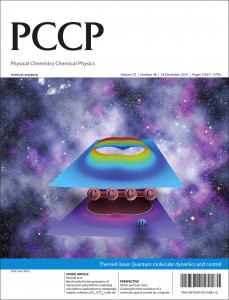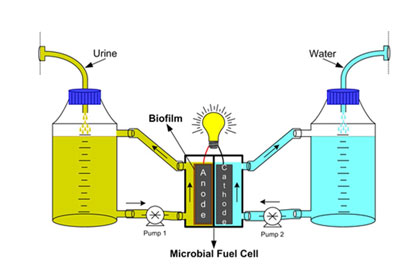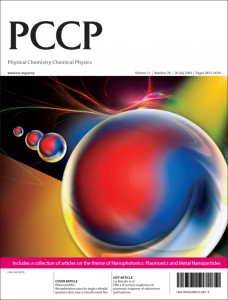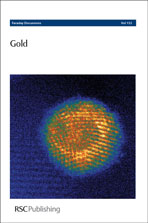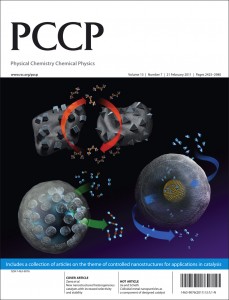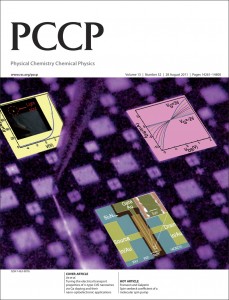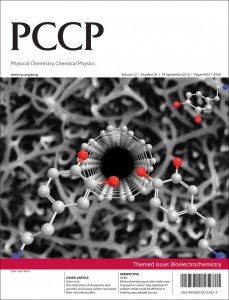 Physical Chemistry Chemical Physics (PCCP) Advisory Board member Professor Rob Hillman, an expert in the field of electrochemistry, has picked his favourite articles recently published in this area in PCCP. He has also added his own comments on why he particularly liked each article.
Physical Chemistry Chemical Physics (PCCP) Advisory Board member Professor Rob Hillman, an expert in the field of electrochemistry, has picked his favourite articles recently published in this area in PCCP. He has also added his own comments on why he particularly liked each article.
Read Professor Hillman’s Editor’s choice selection along with his comments on each article today:
An authoritative and insightful review of protein film electrochemistry and the molecular basis of activity-potential relationships exemplified by nitrate reductase:
The relationship between redox enzyme activity and electrochemical potential—cellular and mechanistic implications from protein film electrochemistry
Andrew J. Gates, Gemma L. Kemp, Chun Yip To, James Mann, Sophie J. Marritt, Andrew G. Mayes, David J. Richardson and Julea N. Butt
DOI: 10.1039/C0CP02887H
Observation of a novel correlation between mechanical deformation (surface strain) and adsorption energetics, as classically manifested via “volcano” plots for hydrogen evolution kinetics:
Impact of surface mechanics on the reactivity of electrodes
J. Weissmüller, R. N. Viswanath, L. A. Kibler and D. M. Kolb
DOI: 10.1039/C0CP01742F
Sophisticated integration of quantum calculations and kinetic measurements for coupled proton-electron transfers in H-bond relay systems:
H-bond relays in proton-coupled electron transfers. Oxidation of a phenol concerted with proton transport to a distal base through an OH relay
Cyrille Costentin, Marc Robert, Jean-Michel Savéant and Cédric Tard
DOI: 10.1039/C0CP02275F
Collisions of single nanoparticles with a microelectrode produce distinct electrocatalytic signatures, according to whether the particles stick to the surface or interact only transiently:
Stochastic electrochemistry with electrocatalytic nanoparticles at inert ultramicroelectrodes—theory and experiments
Seong Jung Kwon, Hongjun Zhou, Fu-Ren F. Fan, Vasily Vorobyev, Bo Zhang and Allen J. Bard
DOI: 10.1039/C0CP02543G
Sophisticated theoretical modelling of Pt clusters on Pd shell over Au core nanoparticles providing new insights into electrocatalytic activity and suggesting an unexpected growth mode:
A density functional theory approach to mushroom-like platinum clusters on palladium-shell over Au core nanoparticles for high electrocatalytic activity
Sai Duan, Ping-Ping Fang, Feng-Ru Fan, Ian Broadwell, Fang-Zu Yang, De-Yin Wu, Bin Ren, Christian Amatore, Yi Luo, Xin Xu and Zhong-Qun Tian
DOI: 10.1039/C1CP20096H
Application of classical electrodeposition nucleation theory, coupled with EXAFS speciation, to metal deposition from novel green media:
Double layer effects on metal nucleation in deep eutectic solvents
Andrew P. Abbott, John C. Barron, Gero Frisch, Stephen Gurman, Karl S. Ryder and A. Fernando Silva
DOI: 10.1039/C0CP02244F
Spectroscopic characterization of ethanol electrooxidation on complex, but well-defined, Sn-modified Pt surfaces, including isotopic tracking of the fate of molecular fragments:
Electrochemical and spectroscopic studies of ethanol oxidation on Pt stepped surfaces modified by tin adatoms
Vinicius Del Colle, Janaina Souza-Garcia, Germano Tremiliosi-Filho, Enrique Herrero and Juan M. Feliu
DOI: 10.1039/C1CP20546C
Detailed imaging, scanning tunnelling spectroscopy and electron transfer rate determinations for surface-bound transition metal complexes:
Voltammetry and in situ scanning tunnelling spectroscopy of osmium, iron, and ruthenium complexes of 2,2′:6′,2′′-terpyridine covalently linked to Au(111)-electrodes
Princia Salvatore, Allan Glargaard Hansen, Kasper Moth-Poulsen, Thomas Bjørnholm, Richard John Nichols and Jens Ulstrup
DOI: 10.1039/C1CP21197H
Pd nanoparticles are required to nucleate Au nanoparticle formation at a liquid/liquid interface, following interfacial transfer into the organic phase of a species shown by XANES to be [AuCl4]–:
Inhibited and enhanced nucleation of gold nanoparticles at the water|1,2-dichloroethane interface
Yvonne Gründer, Huong L. T. Ho, J. Fred W. Mosselmans, Sven L. M. Schroeder and Robert A. W. Dryfe
DOI: 10.1039/C1CP21536A
Elegant templated electrochemical fabrication of complex interfacial structures for controlled SERS enhancement of organic adsorbate:
SERS from two-tier sphere segment void substrates
Robert P. Johnson, Sumeet Mahajan, Mamdouh E. Abdelsalam, Robin M. Cole, Jeremy J. Baumberg, Andrea E. Russell and Philip N. Bartlett
DOI: 10.1039/C1CP21126A
Elegant in situ EXAFS on well-defined Pt surfaces yields features of PtO formation relevant to oxygen reduction in fuel cells:
In situ X-ray probing reveals fingerprints of surface platinum oxide
Daniel Friebel, Daniel J. Miller, Christopher P. O’Grady, Toyli Anniyev, John Bargar, Uwe Bergmann, Hirohito Ogasawara, Kjartan Thor Wikfeldt, Lars G. M. Pettersson and Anders Nilsson
DOI: 10.1039/C0CP01434F
Novel generic model for an electrochemical oscillator, showing complex spatiotemporal patterns with shrimp-like domains:
Self-organized distribution of periodicity and chaos in an electrochemical oscillator
Melke A. Nascimento, Jason A. C. Gallas and Hamilton Varela
DOI: 10.1039/C0CP01038C
Ag deposit structure is determined by the concentrations of silver precursor and the reductant in the two liquid phases; careful optimization yields nanowires:
The growth of single crystal silver wires at the nitrobenzene|water interface
Ulrich Hasse, Gottfried J. Palm, Winfried Hinrichs, Jan Schäfer and Fritz Scholz
DOI: 10.1039/C0CP01469A
A combination of spectroscopic probes yields insight into the interactions between oligothiophenes and carbon nanotubes:
The charging of the carbon nanotube/oligothiophene interphase as studied by in situ electron spin resonance/UV-Vis-NIR spectroelectrochemistry
Kinga Haubner, Karol Luspai, Peter Rapta and Lothar Dunsch
DOI: 10.1039/C1CP20738E
Au nanoparticles at the water/dichloroethane interface enhance photocurrents associated with quenching of a Zn(porphyrin)species by ferrocene:
Photocurrents at polarized liquid|liquid interfaces enhanced by a gold nanoparticle film
Delphine Schaming, Mohamad Hojeij, Nathalie Younan, Hirohisa Nagatani, Hye Jin Lee and Hubert H. Girault
DOI: 10.1039/C1CP22072A
Publishing work of the highest quality in the broad fields of physical chemistry, chemical physics and biophysical chemistry, PCCP is the ideal place to publish your research.
On behalf of the Editorial Board we invite you to submit your best work to PCCP.
PCCP now offers you the chance to publish your accepted article as an Accepted Manuscript. This means that your research is available, in citable form, to the community even more rapidly. Click here to find out more.
 We are delighted to announce that the PCCP themed issue on Physics and Chemistry of Cold Molecules has now been published online – take a look today!
We are delighted to announce that the PCCP themed issue on Physics and Chemistry of Cold Molecules has now been published online – take a look today!










